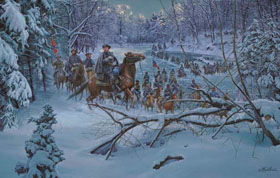 |
Civil War Battles |
|
State War Records |
| AL - AK - AZ - AR - CA - CO - CT - DE - FL - GA - HI - ID - IL - IN - IA - KS - KY - LA - MA - MD - ME - MI - MN - MS - MO - MT - NE - NV - NH - NJ - NM - NY - NC - ND - OH - OK - OR - PA - RI - SC - SD - TN - TX - UT - VT - VA - WA - WV - WI - WY |
The Battle of Columbia
November 24-29, 1864 in Columbia, Maury County, Tennessee
 |
|||||||||||||||||||||
|
Conflict near Columbia, during Lt. Gen. John B. Hood's Tennessee invasion, constituted a Confederate diversion as part of a maneuver designed to cross the Duck River upstream and interdict the Union army's line of communications with Nashville. As Hood's army advanced northeastward from Florence, Alabama, Maj. Gen. John M. Schofield's force quickly withdrew from Pulaski to Columbia, arriving on November 24, just ahead of Brig. Gen. Nathan B. Forrest's Confederate cavalry.
On November 24, the Federals built two lines of earthworks south of the town while skirmishing with Confederate cavalry and again the following day. Hood advanced his infantry on the following day but did not assault. He made demonstrations along the front while marching two different corps of his army to Davis Ford, some 5 miles eastward on the Duck River.
Schofield correctly interpreted Hood's moves, but foul weather prevented him from crossing to the north bank before November 28, leaving Columbia to the Confederates. The next day, both armies marched north for Spring Hill. Schofield had slowed Hood's movement but had not stopped him.
